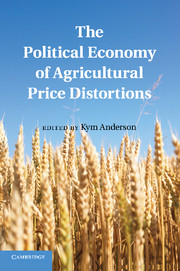Book contents
- Frontmatter
- Contents
- List of Figures
- List of Tables
- Contributors
- Foreword
- Preface
- Abbreviations and Acronyms
- PART ONE Introduction
- PART TWO CONCEPTUAL FRAMEWORKS AND HISTORICAL ORIGINS
- Part Three Political Econometrics: the Past Fifty Years
- NINE Agricultural Price Distortions and Stabilization
- TEN Why Governments Tax or Subsidize Agricultural Trade
- ELEVEN Impacts of Ideology, Inequality, Lobbying, and Public Finance
- TWELVE Agricultural Trade Interventions in Africa
- THIRTEEN Trade Agreements and Trade Barrier Volatility
- FOURTEEN Constitutional Rules and Agricultural Policy Outcomes
- Appendix: Coverage and Distribution of Assistance across Countries and Products, 1955–2007
- Index
- References
FOURTEEN - Constitutional Rules and Agricultural Policy Outcomes
Published online by Cambridge University Press: 05 July 2011
- Frontmatter
- Contents
- List of Figures
- List of Tables
- Contributors
- Foreword
- Preface
- Abbreviations and Acronyms
- PART ONE Introduction
- PART TWO CONCEPTUAL FRAMEWORKS AND HISTORICAL ORIGINS
- Part Three Political Econometrics: the Past Fifty Years
- NINE Agricultural Price Distortions and Stabilization
- TEN Why Governments Tax or Subsidize Agricultural Trade
- ELEVEN Impacts of Ideology, Inequality, Lobbying, and Public Finance
- TWELVE Agricultural Trade Interventions in Africa
- THIRTEEN Trade Agreements and Trade Barrier Volatility
- FOURTEEN Constitutional Rules and Agricultural Policy Outcomes
- Appendix: Coverage and Distribution of Assistance across Countries and Products, 1955–2007
- Index
- References
Summary
The literature concerning political and economic determinants of agricultural protection tends to ignore the role that constitutional rules play in shaping agricultural policies. In contrast, the newly emerging field of comparative political economics places growing emphasis on the effect of political institutions on public policy outcomes. The inclusion of political institutions – such as electoral rules and forms of government – in formal political economy models has produced several testable hypotheses firmly motivated by theory. One of the most influential lines of research in this area is by Persson and Tabellini (2000, 2003), who look at how constitutional rules shape policy outcomes. Other recent contributions along the same research line are those by Grossman and Helpman (2005), who studied the effect of “party discipline” on trade policy, and by Persson (2005), Persson and Tabellini (2006, 2008), Besley and Persson (2008) and Acemoglu and Robinson (2000, 2008) who, among others, look at the economic and political effects of different forms of democracy and the origins of “State Capacity.”
Evidence that links political institutions to agricultural policy outcomes (e.g., Beghin and Kherallah 1994, Swinnen, Banerjee and de Gorter 2001, Henning, Krause and Struve 2002, Olper 2001, Thies and Porsche 2007) provides a weak link with this “new generation” of political economy models, lessening our understanding of the mechanism in place and, consequently, its policy implications. Some contributions have tried to go further, closing the gap between theory and evidence (see Henning 2004, Olper and Raimondi 2004).
- Type
- Chapter
- Information
- The Political Economy of Agricultural Price Distortions , pp. 358 - 392Publisher: Cambridge University PressPrint publication year: 2010
References
- 11
- Cited by



